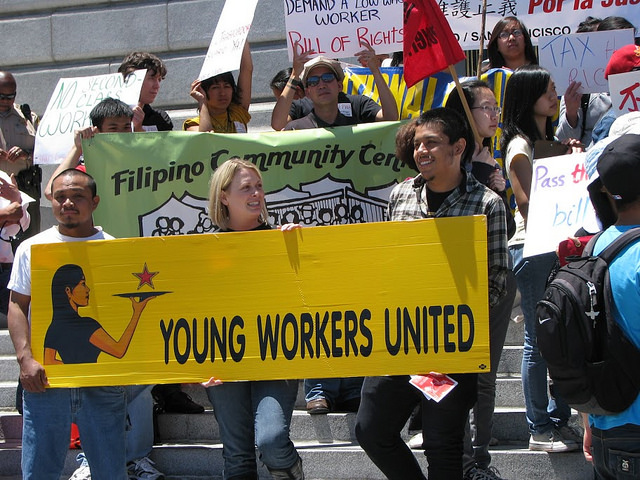While the labour landscape has changed dramatically in Canada in the last 58 years, the legal framework has not. The labour relations framework that we use today in Canada was implemented in 1944 with PC-1003, and the Rand Formula in 1946. The models were based on the Wagner Act of 1935 that was implemented in the United States which gave important legal rights to organized workers. PC-1003 gives legal rights to unions to collectively bargain, represent, and organize workers and the Rand Formula gives the provisions for automatic dues check-offs.
It’s clear that these pieces of legislation are necessary to the viability of the labour movement, however there need to be some updates. In 1944 organizing was radically different from today, as was the labour landscape. Industrial and manufacturing sectors are shrinking and today the largest employment growth is in the retail/service sector, accounting for 11.5 per cent of all employment in Canada in 2011. These new jobs are mainly precarious and non-union, with fast food and mall jobs becoming more common. They usually pay minimum wage, lack stable hours, and provide few or no benefits. Even union retail/service workplaces jobs are becoming increasingly precarious. The push from non-union competitors sets the tone for how union retail/service workplaces operate their business. In today’s unionized retail/service sectors the employers intentionally hire young workers with the knowledge they aren’t well informed about their workplace rights. In addition, even in unionized retail/service workplaces the opportunity of full-time hours or even a guarantee of set hours is unlikely.
Unions are trying to organize the precarious non-unionized sector, but at the same time they’re finding it increasingly difficult just to protect their current members. Whether union or non-union, the retail/service sector is precarious, and this push comes from neoliberal policies that have become more normalized and mainstream in recent years.
The push from corporate elites to undermine labour legislation has resulted in the weakening of card-check legislation and automatic certifications, attempts to enact so-called right to work, attacks on the Rand Formula, and more recently the assault on unions through attempts to impose onerous financial reporting regulations on unions and restrictions on their social justice activities.
This assault on workers is making it increasingly difficult for unions to expand into areas where they need to gain ground. For example, the growing retail sector is characterized by high turnover and the ability to jump between workplaces, making it difficult for unions to organize. However if we want a healthy and sustainable labour movement we must find new ways to connect with the many young people who work in this sector.
Unions are realizing that they must organize these workers; it is critical for the viability of unions, but also for the workers. Despite the reality that Monday to Friday 9-5 jobs are a distant memory, unions can still achieve better scheduling provisions, fair wage increases, respect and dignity, benefits, and the right for workers to have a democratic, participatory role in their workplaces. Youth want to organize, and the unions want to organize them, but the labour relations framework doesn’t allow for this to happen effectively with the changes brought on through increases in retail/service jobs.
In today’s society young people want to take collective action against all kinds of injustice but are often doing this in non-traditional ways that are grassroots and association based; such as community coalitions, worker co-operatives, and employee associations, rather than through formalized structures such as unions. The problem is that under the current labour relations framework, these grassroots- and association-based structures don’t have any legal rights in terms of the employment relationship. Under these systems employees cannot formally negotiate collective agreements, and they can’t access grievance and arbitration procedures. Therefore unionization is still the best option for achieving workplace rights.
While unions want to have more inclusivity and broader representation they haven’t been able to work out some of the internal barriers that allow for this to occur. Their often-hierarchal structures don’t always reflect the diversity of the labour market today. This allows for things to remain status quo, and active young people who would like to give voice to change aren’t always given the opportunity.
Unions must recognize that in order to work they must allow youth to take on participatory roles in all aspects of the union — organizing drives, negotiations, advisory and executive boards, and even take on staff positions. Unions must begin to reflect the workforce they’re looking to organize. There are some unions doing this, and it’s creating positive changes. Yet the biggest change that needs to occur is that young people and unions must come together to find ways for a new organizing model that is successful; perhaps the Wagner model isn’t it.
The challenge is great. The legislative changes required to give the labour movement the tools it needs to organize increasing numbers of precarious youth will only come about with a substantial sea change in our political landscape. Before this will happen, more youth must become engaged in politics and in the labour movement, and labour must increasingly reach out to youth.
Gabriel Bako is major in the Labour Studies Department at the University of Manitoba and a member of UFCW 832.
Photo: peoplesworld/flickr



